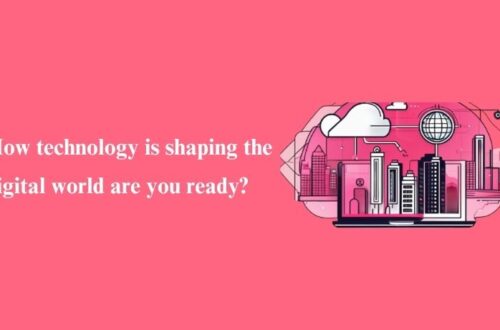The rise of digital technology has reshaped how we interact, work, and live. The contrast between the digital world and the physical world has become a subject of debate, influencing social interactions, mental health, business, and daily activities. This article explores the key differences, advantages, disadvantages, and the psychological effects of living in both worlds.
How Is the Digital World Different from the Physical World?
The digital world refers to the virtual space created by the internet, technology, and digital interactions. It includes online communication, social media, virtual reality, and digital transactions. The physical world, on the other hand, is the tangible, real-world environment where face-to-face interactions, physical work, and real-life experiences take place.
Key Differences:
- Interaction: The digital world allows instant communication across the globe, while the physical world relies on direct, face-to-face interactions.
- Experience: The digital world is largely visual and auditory, whereas the physical world engages all senses.
- Convenience: Digital transactions, remote work, and online learning offer convenience, whereas physical interactions provide authenticity and emotional depth.
- Privacy: Digital activities can be tracked, stored, and analyzed, unlike private conversations in the physical world.
Advantages and Disadvantages of Digital and Physical Worlds
Advantages of the Digital World:
- Connectivity: Enables global communication and collaboration.
- Efficiency: Faster transactions, automation, and data management.
- Information Access: Quick access to knowledge, resources, and services.
- Flexibility: Remote work, e-learning, and telehealth.
Disadvantages of the Digital World:
- Lack of Personal Interaction: Reduced emotional depth in relationships.
- Privacy Risks: Data breaches, identity theft, and surveillance concerns.
- Digital Addiction: Overuse of screens leads to social disconnection and health issues.
- Misinformation: Fake news and digital manipulation spread easily.
Advantages of the Physical World:
- Authentic Relationships: Stronger emotional connections and body language cues.
- Physical Well-Being: More movement, less screen exposure.
- Hands-on Experience: Practical skills and sensory learning.
- Privacy & Security: Fewer risks of digital tracking.
Disadvantages of the Physical World:
- Limited Reach: Communication and access to opportunities are restricted.
- Inefficiency: Longer processes for tasks like banking, shopping, or studying.
- Higher Costs: Travel, physical office spaces, and printed materials add expenses.
Impact of Digitalization on the Real World
Digitalization has transformed industries, lifestyles, and global economies. The shift toward automation, artificial intelligence, and remote connectivity has redefined human interactions and business models.
Key Impacts:
- Work & Economy: Digital platforms enable remote jobs, freelancing, and automation, reducing reliance on traditional employment.
- Education: Online courses and virtual classrooms have replaced traditional learning methods.
- Healthcare: Telemedicine and AI-driven diagnostics improve accessibility.
- Shopping & Entertainment: E-commerce and digital streaming have changed consumer behavior.
- Social Interactions: Virtual connections are replacing face-to-face meetings.
How Technology Is Changing the Physical World
The integration of technology into daily life is blurring the lines between the digital and physical worlds.
Notable Changes:
- Smart Cities: IoT-driven urban planning enhances efficiency.
- Augmented Reality (AR): Blends digital and physical environments in gaming, shopping, and education.
- Wearable Tech: Smartwatches and fitness trackers monitor health in real-time.
- Digital Payments: Cashless transactions increase convenience.
- AI in Daily Life: Virtual assistants, automation, and AI-driven decision-making streamline activities.
Pros and Cons of Living in a Digital World vs. Real Life
| Factor | Digital World | Physical World |
| Social Interaction | Virtual, accessible, but impersonal | Deep connections, but location-based |
| Learning | Online courses, digital libraries | Hands-on learning, traditional classrooms |
| Work | Remote jobs, freelancing | Office culture, face-to-face collaboration |
| Convenience | Fast and efficient | Requires time and effort |
| Privacy | Data tracking, cybersecurity risks | More secure, less surveillance |
| Mental Health | Digital addiction, screen fatigue | Real-world stress, environmental challenges |
The Role of the Internet in Shaping the Digital World
The internet has been the backbone of the digital revolution, transforming communication, business, and education.
Major Roles:
- Global Connectivity: Brings people together regardless of geography.
- E-Commerce Growth: Enables businesses to expand beyond physical locations.
- AI and Big Data: Enhances decision-making, automation, and analytics.
- Entertainment Industry: Revolutionized music, movies, and gaming.
- Social Activism: Raises awareness and mobilizes movements globally.
Digital vs. Physical Interactions: What’s Better?
While digital communication provides speed and accessibility, physical interactions offer emotional depth and authenticity.
Digital Communication Pros:
- Instant messaging and video calls bridge distances.
- Asynchronous communication allows flexibility.
- Social media enables networking and outreach.
Physical Interaction Pros:
- Builds stronger relationships with non-verbal cues.
- More effective in negotiations and emotional discussions.
- Reduces misunderstandings compared to text-based communication.
How Does Social Media Affect Real-Life Communication?
Social media has redefined how people connect, but it also has drawbacks.
Positive Effects:
- Helps maintain long-distance relationships.
- Raises awareness on global issues.
- Provides a platform for self-expression.
Negative Effects:
- Reduces face-to-face interactions.
- Encourages unrealistic comparisons, affecting self-esteem.
- Increases digital distractions during real-life conversations.
The Balance Between Digital Life and Physical Experiences
Maintaining a balance between digital and physical life is crucial for mental and social well-being.
Tips for Balance:
- Set Screen Time Limits: Reduce digital exposure to prevent addiction.
- Prioritize In-Person Interaction: Make time for real-life socializing.
- Engage in Outdoor Activities: Reduce digital dependency with physical hobbies.
- Use Technology Wisely: Focus on productivity rather than mindless scrolling.
Psychological Effects of Living in a Digital vs. Physical World
Digital dependence can have both positive and negative psychological effects.
Positive:
- Increases knowledge and skill development.
- Connects like-minded communities.
- Provides mental stimulation through interactive content.
Negative:
- Anxiety & Depression: Social media pressures and cyberbullying.
- Attention Span Reduction: Fast-paced digital content reduces deep focus.
- Isolation: Excessive digital interaction can lead to loneliness.
Conclusion
The digital and physical worlds offer unique benefits and challenges. While digitalization provides convenience, accessibility, and efficiency, the physical world fosters deeper human connections, authenticity, and real-life experiences. Striking the right balance between both worlds is essential for a fulfilling and healthy lifestyle.






